Evidence Based Nursing Research: Critique of a Qualitative Fall Study
VerifiedAdded on 2023/06/13
|12
|4700
|370
Essay
AI Summary
This essay presents a critical evaluation of a qualitative research study titled "Patient perceptions and experiences with falls during hospitalization and after discharge" by Shuman et al. (2016). The essay utilizes Ryan's (2007) framework to analyze the study's significance, literature review, research design, sampling methods, ethical considerations, and data collection techniques. The study explores older adults' perceptions of fall risks, fall prevention interventions received during hospitalization, and fall prevention discharge instructions. The review highlights the importance of understanding patient perceptions to improve fall prevention strategies and enhance patient education. The critique identifies strengths in the study's aim, prospective exploratory design, and data collection methods, while also pointing out limitations in sampling justification, lack of detail regarding participant demographics, and the absence of information on ethical board approval and participant rights to withdraw. Overall, the essay assesses the study's contribution to nursing knowledge and practice, emphasizing the need for further research in this area.
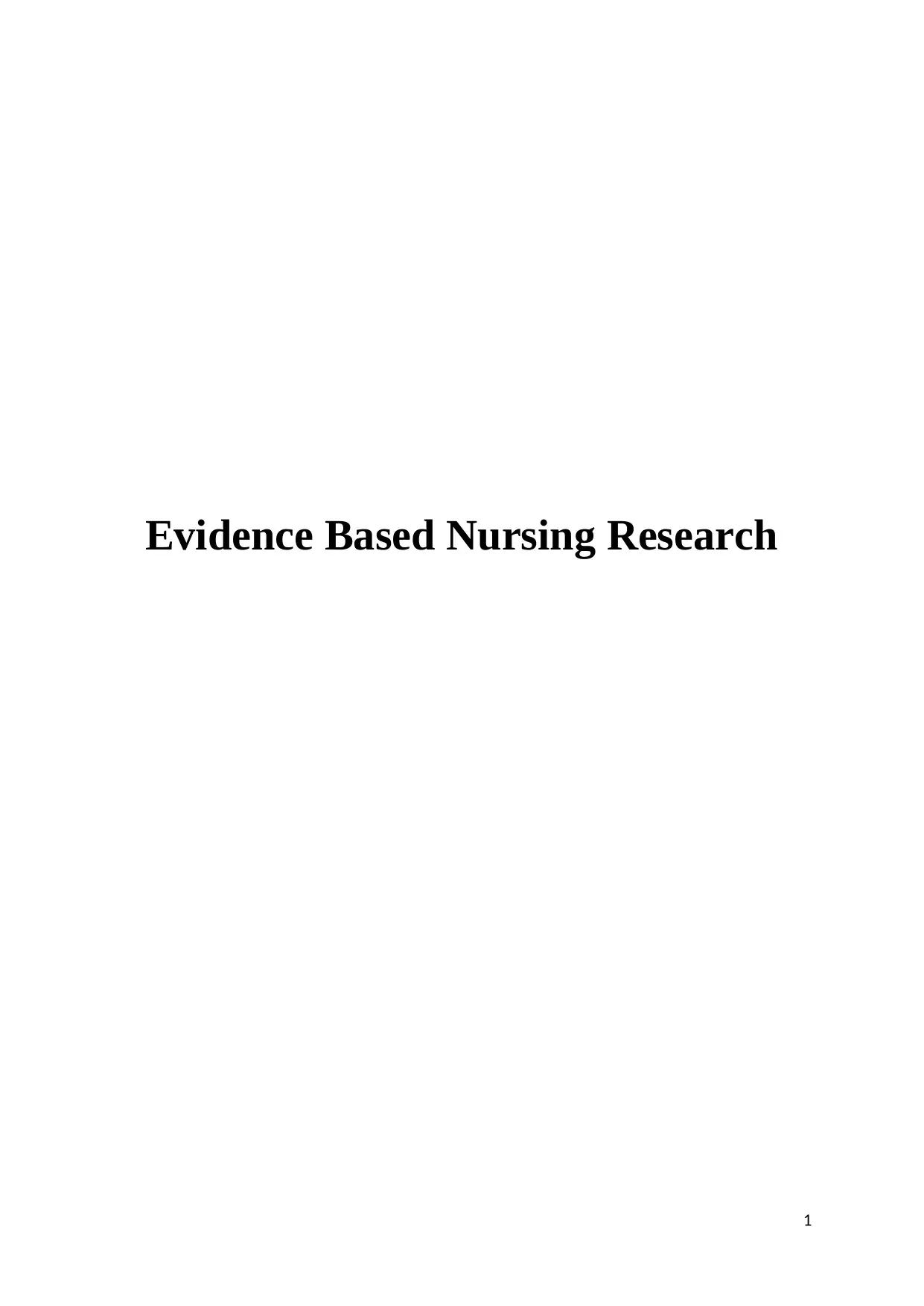
Evidence Based Nursing Research
1
1
Paraphrase This Document
Need a fresh take? Get an instant paraphrase of this document with our AI Paraphraser
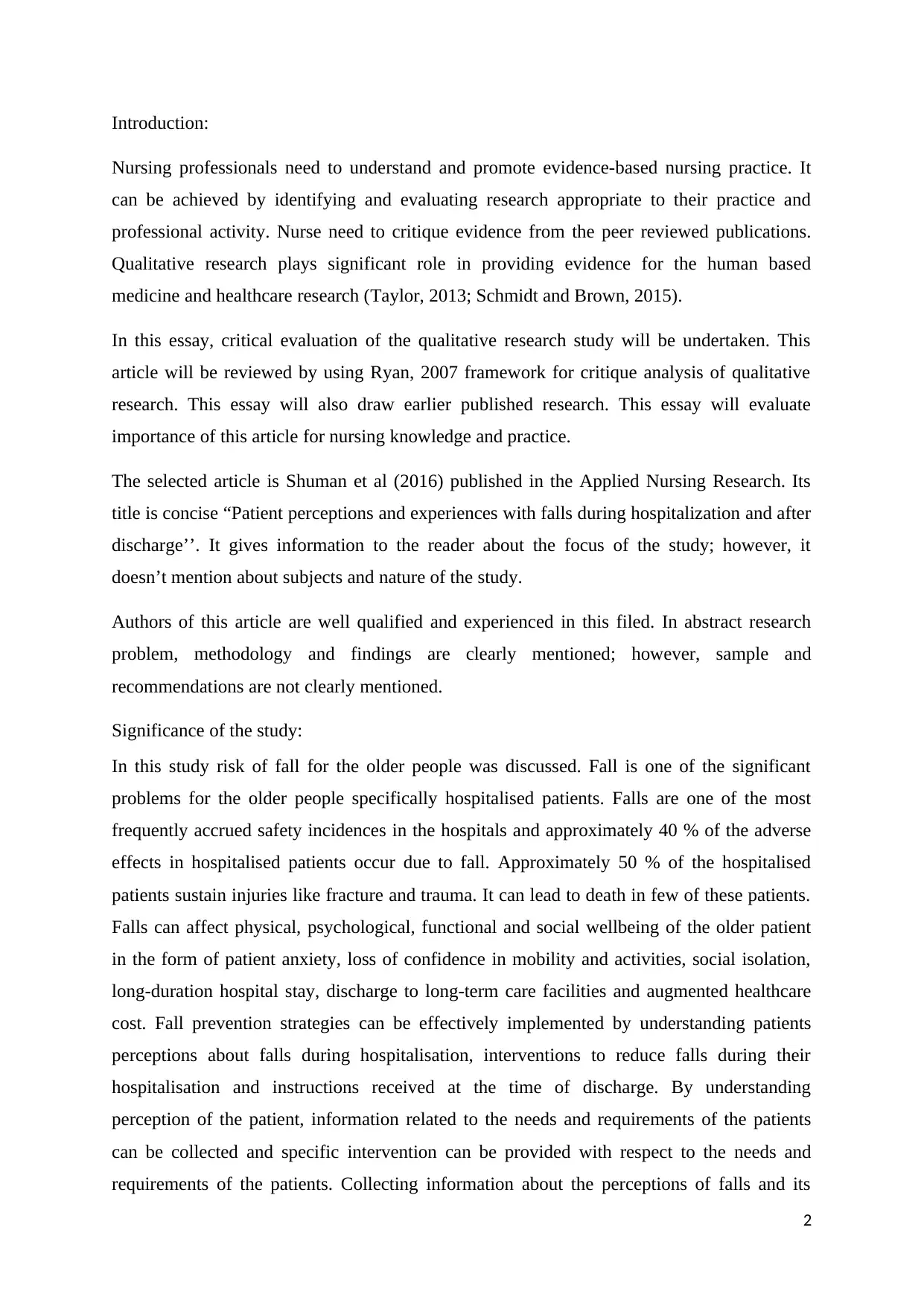
Introduction:
Nursing professionals need to understand and promote evidence-based nursing practice. It
can be achieved by identifying and evaluating research appropriate to their practice and
professional activity. Nurse need to critique evidence from the peer reviewed publications.
Qualitative research plays significant role in providing evidence for the human based
medicine and healthcare research (Taylor, 2013; Schmidt and Brown, 2015).
In this essay, critical evaluation of the qualitative research study will be undertaken. This
article will be reviewed by using Ryan, 2007 framework for critique analysis of qualitative
research. This essay will also draw earlier published research. This essay will evaluate
importance of this article for nursing knowledge and practice.
The selected article is Shuman et al (2016) published in the Applied Nursing Research. Its
title is concise “Patient perceptions and experiences with falls during hospitalization and after
discharge’’. It gives information to the reader about the focus of the study; however, it
doesn’t mention about subjects and nature of the study.
Authors of this article are well qualified and experienced in this filed. In abstract research
problem, methodology and findings are clearly mentioned; however, sample and
recommendations are not clearly mentioned.
Significance of the study:
In this study risk of fall for the older people was discussed. Fall is one of the significant
problems for the older people specifically hospitalised patients. Falls are one of the most
frequently accrued safety incidences in the hospitals and approximately 40 % of the adverse
effects in hospitalised patients occur due to fall. Approximately 50 % of the hospitalised
patients sustain injuries like fracture and trauma. It can lead to death in few of these patients.
Falls can affect physical, psychological, functional and social wellbeing of the older patient
in the form of patient anxiety, loss of confidence in mobility and activities, social isolation,
long-duration hospital stay, discharge to long-term care facilities and augmented healthcare
cost. Fall prevention strategies can be effectively implemented by understanding patients
perceptions about falls during hospitalisation, interventions to reduce falls during their
hospitalisation and instructions received at the time of discharge. By understanding
perception of the patient, information related to the needs and requirements of the patients
can be collected and specific intervention can be provided with respect to the needs and
requirements of the patients. Collecting information about the perceptions of falls and its
2
Nursing professionals need to understand and promote evidence-based nursing practice. It
can be achieved by identifying and evaluating research appropriate to their practice and
professional activity. Nurse need to critique evidence from the peer reviewed publications.
Qualitative research plays significant role in providing evidence for the human based
medicine and healthcare research (Taylor, 2013; Schmidt and Brown, 2015).
In this essay, critical evaluation of the qualitative research study will be undertaken. This
article will be reviewed by using Ryan, 2007 framework for critique analysis of qualitative
research. This essay will also draw earlier published research. This essay will evaluate
importance of this article for nursing knowledge and practice.
The selected article is Shuman et al (2016) published in the Applied Nursing Research. Its
title is concise “Patient perceptions and experiences with falls during hospitalization and after
discharge’’. It gives information to the reader about the focus of the study; however, it
doesn’t mention about subjects and nature of the study.
Authors of this article are well qualified and experienced in this filed. In abstract research
problem, methodology and findings are clearly mentioned; however, sample and
recommendations are not clearly mentioned.
Significance of the study:
In this study risk of fall for the older people was discussed. Fall is one of the significant
problems for the older people specifically hospitalised patients. Falls are one of the most
frequently accrued safety incidences in the hospitals and approximately 40 % of the adverse
effects in hospitalised patients occur due to fall. Approximately 50 % of the hospitalised
patients sustain injuries like fracture and trauma. It can lead to death in few of these patients.
Falls can affect physical, psychological, functional and social wellbeing of the older patient
in the form of patient anxiety, loss of confidence in mobility and activities, social isolation,
long-duration hospital stay, discharge to long-term care facilities and augmented healthcare
cost. Fall prevention strategies can be effectively implemented by understanding patients
perceptions about falls during hospitalisation, interventions to reduce falls during their
hospitalisation and instructions received at the time of discharge. By understanding
perception of the patient, information related to the needs and requirements of the patients
can be collected and specific intervention can be provided with respect to the needs and
requirements of the patients. Collecting information about the perceptions of falls and its
2
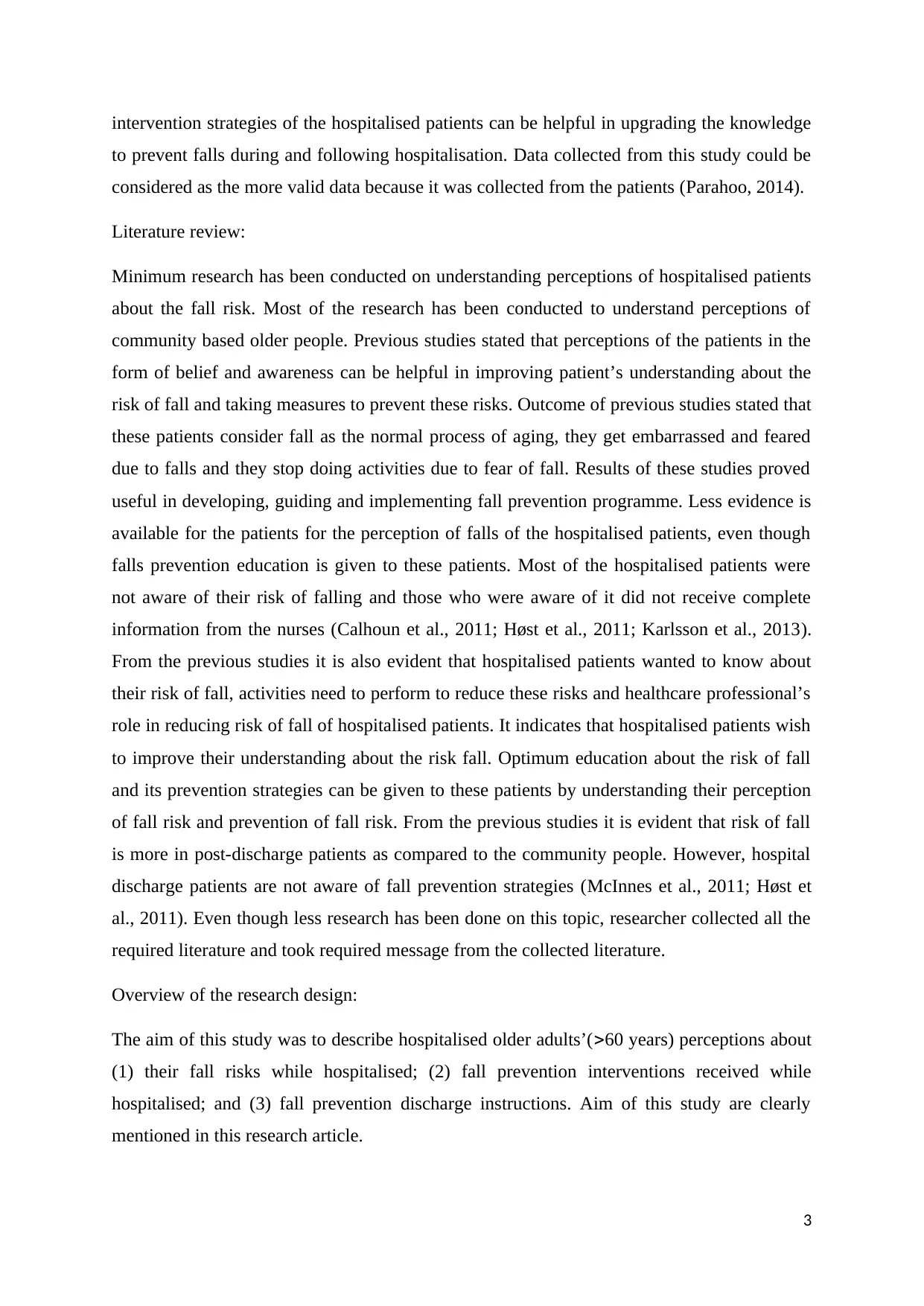
intervention strategies of the hospitalised patients can be helpful in upgrading the knowledge
to prevent falls during and following hospitalisation. Data collected from this study could be
considered as the more valid data because it was collected from the patients (Parahoo, 2014).
Literature review:
Minimum research has been conducted on understanding perceptions of hospitalised patients
about the fall risk. Most of the research has been conducted to understand perceptions of
community based older people. Previous studies stated that perceptions of the patients in the
form of belief and awareness can be helpful in improving patient’s understanding about the
risk of fall and taking measures to prevent these risks. Outcome of previous studies stated that
these patients consider fall as the normal process of aging, they get embarrassed and feared
due to falls and they stop doing activities due to fear of fall. Results of these studies proved
useful in developing, guiding and implementing fall prevention programme. Less evidence is
available for the patients for the perception of falls of the hospitalised patients, even though
falls prevention education is given to these patients. Most of the hospitalised patients were
not aware of their risk of falling and those who were aware of it did not receive complete
information from the nurses (Calhoun et al., 2011; Høst et al., 2011; Karlsson et al., 2013).
From the previous studies it is also evident that hospitalised patients wanted to know about
their risk of fall, activities need to perform to reduce these risks and healthcare professional’s
role in reducing risk of fall of hospitalised patients. It indicates that hospitalised patients wish
to improve their understanding about the risk fall. Optimum education about the risk of fall
and its prevention strategies can be given to these patients by understanding their perception
of fall risk and prevention of fall risk. From the previous studies it is evident that risk of fall
is more in post-discharge patients as compared to the community people. However, hospital
discharge patients are not aware of fall prevention strategies (McInnes et al., 2011; Høst et
al., 2011). Even though less research has been done on this topic, researcher collected all the
required literature and took required message from the collected literature.
Overview of the research design:
The aim of this study was to describe hospitalised older adults’(60 years) perceptions about
(1) their fall risks while hospitalised; (2) fall prevention interventions received while
hospitalised; and (3) fall prevention discharge instructions. Aim of this study are clearly
mentioned in this research article.
3
to prevent falls during and following hospitalisation. Data collected from this study could be
considered as the more valid data because it was collected from the patients (Parahoo, 2014).
Literature review:
Minimum research has been conducted on understanding perceptions of hospitalised patients
about the fall risk. Most of the research has been conducted to understand perceptions of
community based older people. Previous studies stated that perceptions of the patients in the
form of belief and awareness can be helpful in improving patient’s understanding about the
risk of fall and taking measures to prevent these risks. Outcome of previous studies stated that
these patients consider fall as the normal process of aging, they get embarrassed and feared
due to falls and they stop doing activities due to fear of fall. Results of these studies proved
useful in developing, guiding and implementing fall prevention programme. Less evidence is
available for the patients for the perception of falls of the hospitalised patients, even though
falls prevention education is given to these patients. Most of the hospitalised patients were
not aware of their risk of falling and those who were aware of it did not receive complete
information from the nurses (Calhoun et al., 2011; Høst et al., 2011; Karlsson et al., 2013).
From the previous studies it is also evident that hospitalised patients wanted to know about
their risk of fall, activities need to perform to reduce these risks and healthcare professional’s
role in reducing risk of fall of hospitalised patients. It indicates that hospitalised patients wish
to improve their understanding about the risk fall. Optimum education about the risk of fall
and its prevention strategies can be given to these patients by understanding their perception
of fall risk and prevention of fall risk. From the previous studies it is evident that risk of fall
is more in post-discharge patients as compared to the community people. However, hospital
discharge patients are not aware of fall prevention strategies (McInnes et al., 2011; Høst et
al., 2011). Even though less research has been done on this topic, researcher collected all the
required literature and took required message from the collected literature.
Overview of the research design:
The aim of this study was to describe hospitalised older adults’(60 years) perceptions about
(1) their fall risks while hospitalised; (2) fall prevention interventions received while
hospitalised; and (3) fall prevention discharge instructions. Aim of this study are clearly
mentioned in this research article.
3
⊘ This is a preview!⊘
Do you want full access?
Subscribe today to unlock all pages.

Trusted by 1+ million students worldwide
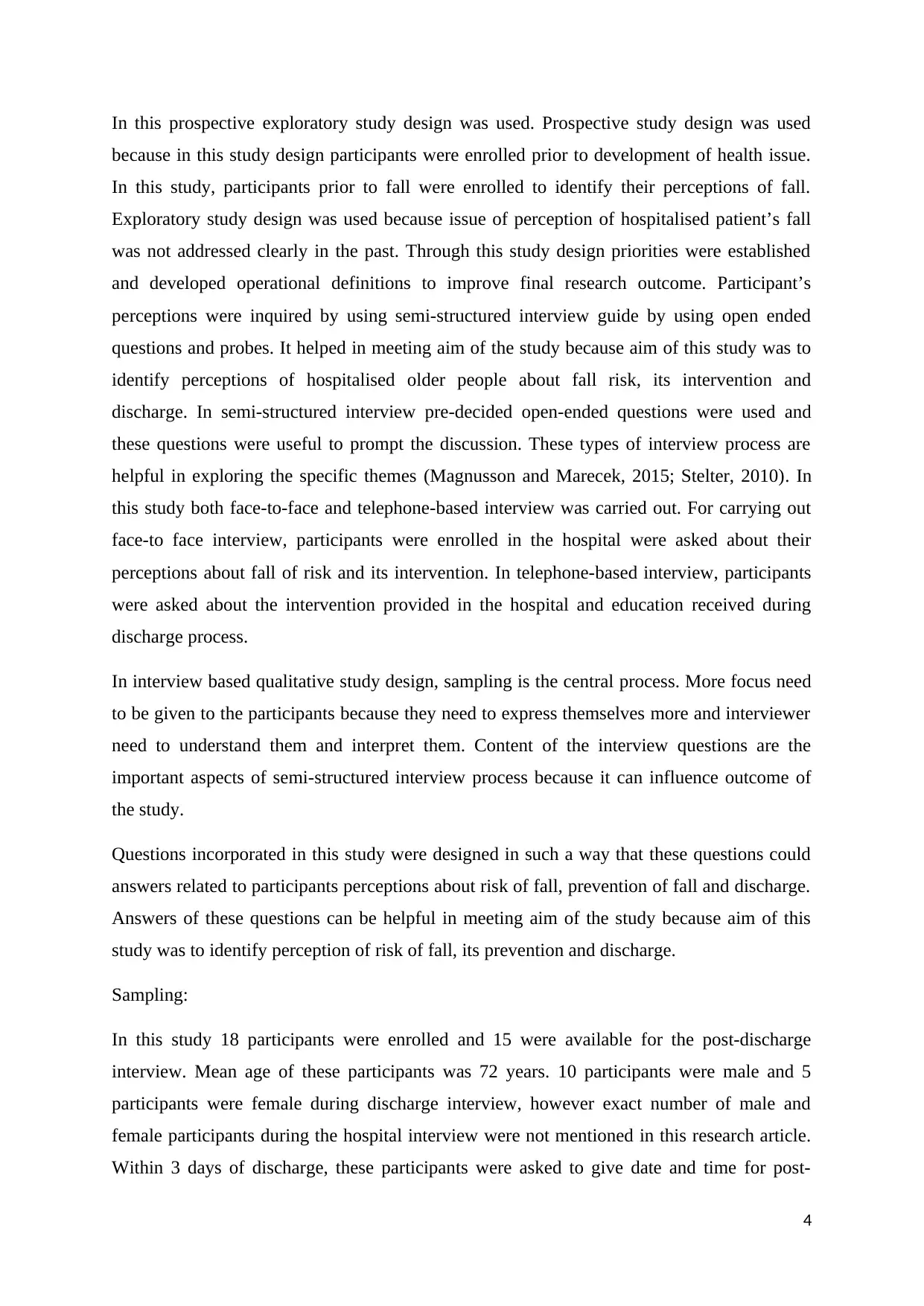
In this prospective exploratory study design was used. Prospective study design was used
because in this study design participants were enrolled prior to development of health issue.
In this study, participants prior to fall were enrolled to identify their perceptions of fall.
Exploratory study design was used because issue of perception of hospitalised patient’s fall
was not addressed clearly in the past. Through this study design priorities were established
and developed operational definitions to improve final research outcome. Participant’s
perceptions were inquired by using semi-structured interview guide by using open ended
questions and probes. It helped in meeting aim of the study because aim of this study was to
identify perceptions of hospitalised older people about fall risk, its intervention and
discharge. In semi-structured interview pre-decided open-ended questions were used and
these questions were useful to prompt the discussion. These types of interview process are
helpful in exploring the specific themes (Magnusson and Marecek, 2015; Stelter, 2010). In
this study both face-to-face and telephone-based interview was carried out. For carrying out
face-to face interview, participants were enrolled in the hospital were asked about their
perceptions about fall of risk and its intervention. In telephone-based interview, participants
were asked about the intervention provided in the hospital and education received during
discharge process.
In interview based qualitative study design, sampling is the central process. More focus need
to be given to the participants because they need to express themselves more and interviewer
need to understand them and interpret them. Content of the interview questions are the
important aspects of semi-structured interview process because it can influence outcome of
the study.
Questions incorporated in this study were designed in such a way that these questions could
answers related to participants perceptions about risk of fall, prevention of fall and discharge.
Answers of these questions can be helpful in meeting aim of the study because aim of this
study was to identify perception of risk of fall, its prevention and discharge.
Sampling:
In this study 18 participants were enrolled and 15 were available for the post-discharge
interview. Mean age of these participants was 72 years. 10 participants were male and 5
participants were female during discharge interview, however exact number of male and
female participants during the hospital interview were not mentioned in this research article.
Within 3 days of discharge, these participants were asked to give date and time for post-
4
because in this study design participants were enrolled prior to development of health issue.
In this study, participants prior to fall were enrolled to identify their perceptions of fall.
Exploratory study design was used because issue of perception of hospitalised patient’s fall
was not addressed clearly in the past. Through this study design priorities were established
and developed operational definitions to improve final research outcome. Participant’s
perceptions were inquired by using semi-structured interview guide by using open ended
questions and probes. It helped in meeting aim of the study because aim of this study was to
identify perceptions of hospitalised older people about fall risk, its intervention and
discharge. In semi-structured interview pre-decided open-ended questions were used and
these questions were useful to prompt the discussion. These types of interview process are
helpful in exploring the specific themes (Magnusson and Marecek, 2015; Stelter, 2010). In
this study both face-to-face and telephone-based interview was carried out. For carrying out
face-to face interview, participants were enrolled in the hospital were asked about their
perceptions about fall of risk and its intervention. In telephone-based interview, participants
were asked about the intervention provided in the hospital and education received during
discharge process.
In interview based qualitative study design, sampling is the central process. More focus need
to be given to the participants because they need to express themselves more and interviewer
need to understand them and interpret them. Content of the interview questions are the
important aspects of semi-structured interview process because it can influence outcome of
the study.
Questions incorporated in this study were designed in such a way that these questions could
answers related to participants perceptions about risk of fall, prevention of fall and discharge.
Answers of these questions can be helpful in meeting aim of the study because aim of this
study was to identify perception of risk of fall, its prevention and discharge.
Sampling:
In this study 18 participants were enrolled and 15 were available for the post-discharge
interview. Mean age of these participants was 72 years. 10 participants were male and 5
participants were female during discharge interview, however exact number of male and
female participants during the hospital interview were not mentioned in this research article.
Within 3 days of discharge, these participants were asked to give date and time for post-
4
Paraphrase This Document
Need a fresh take? Get an instant paraphrase of this document with our AI Paraphraser
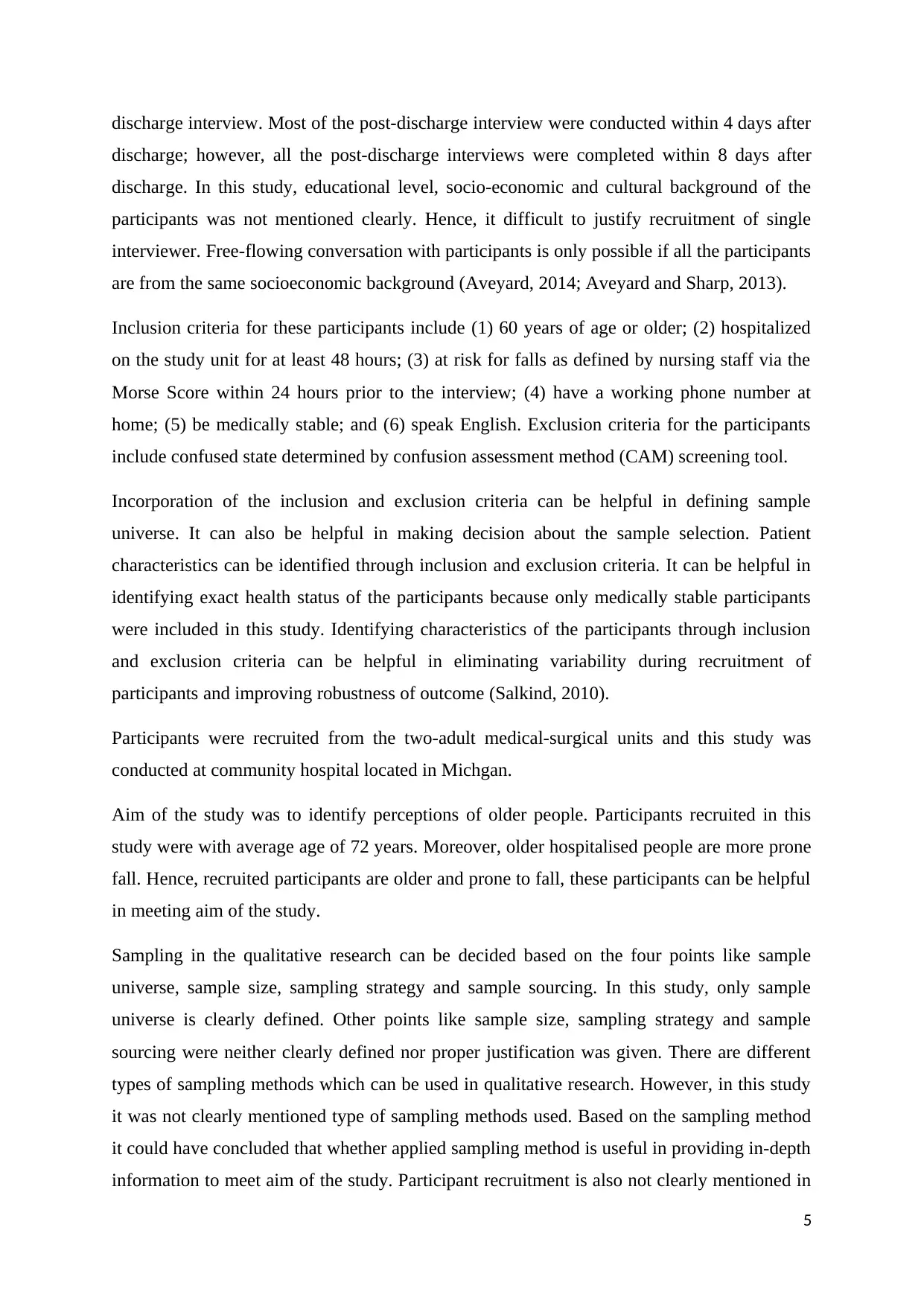
discharge interview. Most of the post-discharge interview were conducted within 4 days after
discharge; however, all the post-discharge interviews were completed within 8 days after
discharge. In this study, educational level, socio-economic and cultural background of the
participants was not mentioned clearly. Hence, it difficult to justify recruitment of single
interviewer. Free-flowing conversation with participants is only possible if all the participants
are from the same socioeconomic background (Aveyard, 2014; Aveyard and Sharp, 2013).
Inclusion criteria for these participants include (1) 60 years of age or older; (2) hospitalized
on the study unit for at least 48 hours; (3) at risk for falls as defined by nursing staff via the
Morse Score within 24 hours prior to the interview; (4) have a working phone number at
home; (5) be medically stable; and (6) speak English. Exclusion criteria for the participants
include confused state determined by confusion assessment method (CAM) screening tool.
Incorporation of the inclusion and exclusion criteria can be helpful in defining sample
universe. It can also be helpful in making decision about the sample selection. Patient
characteristics can be identified through inclusion and exclusion criteria. It can be helpful in
identifying exact health status of the participants because only medically stable participants
were included in this study. Identifying characteristics of the participants through inclusion
and exclusion criteria can be helpful in eliminating variability during recruitment of
participants and improving robustness of outcome (Salkind, 2010).
Participants were recruited from the two-adult medical-surgical units and this study was
conducted at community hospital located in Michgan.
Aim of the study was to identify perceptions of older people. Participants recruited in this
study were with average age of 72 years. Moreover, older hospitalised people are more prone
fall. Hence, recruited participants are older and prone to fall, these participants can be helpful
in meeting aim of the study.
Sampling in the qualitative research can be decided based on the four points like sample
universe, sample size, sampling strategy and sample sourcing. In this study, only sample
universe is clearly defined. Other points like sample size, sampling strategy and sample
sourcing were neither clearly defined nor proper justification was given. There are different
types of sampling methods which can be used in qualitative research. However, in this study
it was not clearly mentioned type of sampling methods used. Based on the sampling method
it could have concluded that whether applied sampling method is useful in providing in-depth
information to meet aim of the study. Participant recruitment is also not clearly mentioned in
5
discharge; however, all the post-discharge interviews were completed within 8 days after
discharge. In this study, educational level, socio-economic and cultural background of the
participants was not mentioned clearly. Hence, it difficult to justify recruitment of single
interviewer. Free-flowing conversation with participants is only possible if all the participants
are from the same socioeconomic background (Aveyard, 2014; Aveyard and Sharp, 2013).
Inclusion criteria for these participants include (1) 60 years of age or older; (2) hospitalized
on the study unit for at least 48 hours; (3) at risk for falls as defined by nursing staff via the
Morse Score within 24 hours prior to the interview; (4) have a working phone number at
home; (5) be medically stable; and (6) speak English. Exclusion criteria for the participants
include confused state determined by confusion assessment method (CAM) screening tool.
Incorporation of the inclusion and exclusion criteria can be helpful in defining sample
universe. It can also be helpful in making decision about the sample selection. Patient
characteristics can be identified through inclusion and exclusion criteria. It can be helpful in
identifying exact health status of the participants because only medically stable participants
were included in this study. Identifying characteristics of the participants through inclusion
and exclusion criteria can be helpful in eliminating variability during recruitment of
participants and improving robustness of outcome (Salkind, 2010).
Participants were recruited from the two-adult medical-surgical units and this study was
conducted at community hospital located in Michgan.
Aim of the study was to identify perceptions of older people. Participants recruited in this
study were with average age of 72 years. Moreover, older hospitalised people are more prone
fall. Hence, recruited participants are older and prone to fall, these participants can be helpful
in meeting aim of the study.
Sampling in the qualitative research can be decided based on the four points like sample
universe, sample size, sampling strategy and sample sourcing. In this study, only sample
universe is clearly defined. Other points like sample size, sampling strategy and sample
sourcing were neither clearly defined nor proper justification was given. There are different
types of sampling methods which can be used in qualitative research. However, in this study
it was not clearly mentioned type of sampling methods used. Based on the sampling method
it could have concluded that whether applied sampling method is useful in providing in-depth
information to meet aim of the study. Participant recruitment is also not clearly mentioned in
5
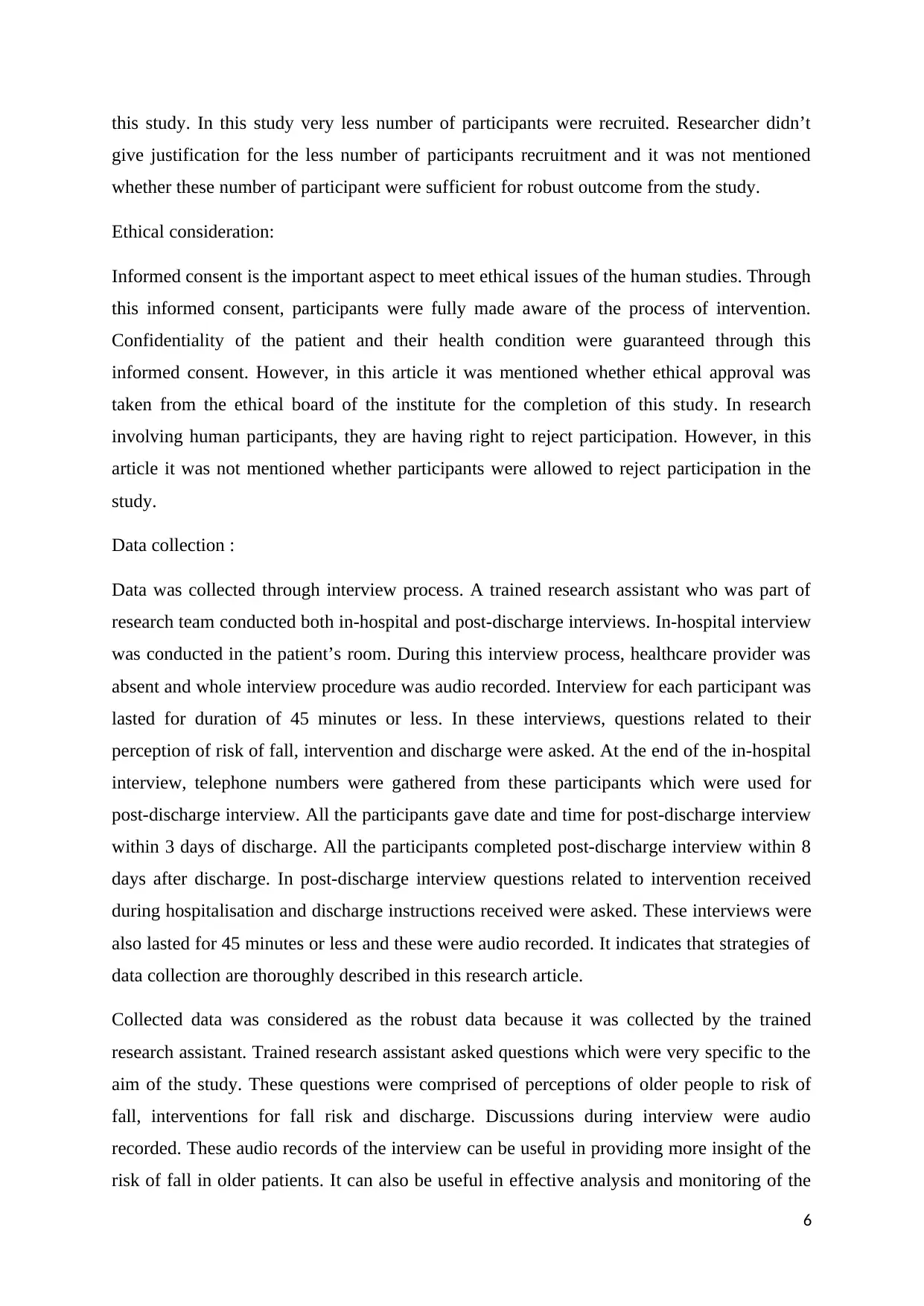
this study. In this study very less number of participants were recruited. Researcher didn’t
give justification for the less number of participants recruitment and it was not mentioned
whether these number of participant were sufficient for robust outcome from the study.
Ethical consideration:
Informed consent is the important aspect to meet ethical issues of the human studies. Through
this informed consent, participants were fully made aware of the process of intervention.
Confidentiality of the patient and their health condition were guaranteed through this
informed consent. However, in this article it was mentioned whether ethical approval was
taken from the ethical board of the institute for the completion of this study. In research
involving human participants, they are having right to reject participation. However, in this
article it was not mentioned whether participants were allowed to reject participation in the
study.
Data collection :
Data was collected through interview process. A trained research assistant who was part of
research team conducted both in-hospital and post-discharge interviews. In-hospital interview
was conducted in the patient’s room. During this interview process, healthcare provider was
absent and whole interview procedure was audio recorded. Interview for each participant was
lasted for duration of 45 minutes or less. In these interviews, questions related to their
perception of risk of fall, intervention and discharge were asked. At the end of the in-hospital
interview, telephone numbers were gathered from these participants which were used for
post-discharge interview. All the participants gave date and time for post-discharge interview
within 3 days of discharge. All the participants completed post-discharge interview within 8
days after discharge. In post-discharge interview questions related to intervention received
during hospitalisation and discharge instructions received were asked. These interviews were
also lasted for 45 minutes or less and these were audio recorded. It indicates that strategies of
data collection are thoroughly described in this research article.
Collected data was considered as the robust data because it was collected by the trained
research assistant. Trained research assistant asked questions which were very specific to the
aim of the study. These questions were comprised of perceptions of older people to risk of
fall, interventions for fall risk and discharge. Discussions during interview were audio
recorded. These audio records of the interview can be useful in providing more insight of the
risk of fall in older patients. It can also be useful in effective analysis and monitoring of the
6
give justification for the less number of participants recruitment and it was not mentioned
whether these number of participant were sufficient for robust outcome from the study.
Ethical consideration:
Informed consent is the important aspect to meet ethical issues of the human studies. Through
this informed consent, participants were fully made aware of the process of intervention.
Confidentiality of the patient and their health condition were guaranteed through this
informed consent. However, in this article it was mentioned whether ethical approval was
taken from the ethical board of the institute for the completion of this study. In research
involving human participants, they are having right to reject participation. However, in this
article it was not mentioned whether participants were allowed to reject participation in the
study.
Data collection :
Data was collected through interview process. A trained research assistant who was part of
research team conducted both in-hospital and post-discharge interviews. In-hospital interview
was conducted in the patient’s room. During this interview process, healthcare provider was
absent and whole interview procedure was audio recorded. Interview for each participant was
lasted for duration of 45 minutes or less. In these interviews, questions related to their
perception of risk of fall, intervention and discharge were asked. At the end of the in-hospital
interview, telephone numbers were gathered from these participants which were used for
post-discharge interview. All the participants gave date and time for post-discharge interview
within 3 days of discharge. All the participants completed post-discharge interview within 8
days after discharge. In post-discharge interview questions related to intervention received
during hospitalisation and discharge instructions received were asked. These interviews were
also lasted for 45 minutes or less and these were audio recorded. It indicates that strategies of
data collection are thoroughly described in this research article.
Collected data was considered as the robust data because it was collected by the trained
research assistant. Trained research assistant asked questions which were very specific to the
aim of the study. These questions were comprised of perceptions of older people to risk of
fall, interventions for fall risk and discharge. Discussions during interview were audio
recorded. These audio records of the interview can be useful in providing more insight of the
risk of fall in older patients. It can also be useful in effective analysis and monitoring of the
6
⊘ This is a preview!⊘
Do you want full access?
Subscribe today to unlock all pages.

Trusted by 1+ million students worldwide
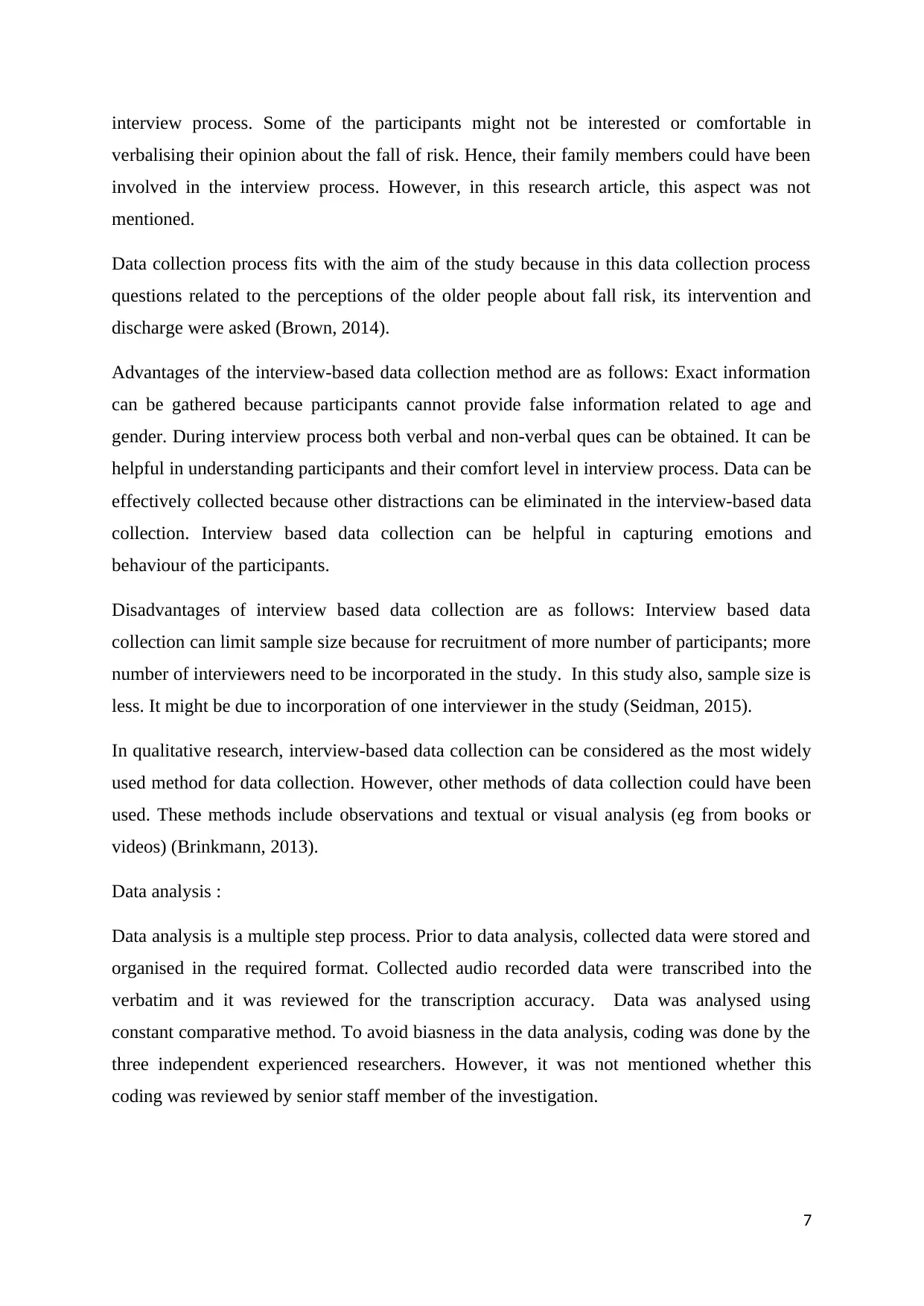
interview process. Some of the participants might not be interested or comfortable in
verbalising their opinion about the fall of risk. Hence, their family members could have been
involved in the interview process. However, in this research article, this aspect was not
mentioned.
Data collection process fits with the aim of the study because in this data collection process
questions related to the perceptions of the older people about fall risk, its intervention and
discharge were asked (Brown, 2014).
Advantages of the interview-based data collection method are as follows: Exact information
can be gathered because participants cannot provide false information related to age and
gender. During interview process both verbal and non-verbal ques can be obtained. It can be
helpful in understanding participants and their comfort level in interview process. Data can be
effectively collected because other distractions can be eliminated in the interview-based data
collection. Interview based data collection can be helpful in capturing emotions and
behaviour of the participants.
Disadvantages of interview based data collection are as follows: Interview based data
collection can limit sample size because for recruitment of more number of participants; more
number of interviewers need to be incorporated in the study. In this study also, sample size is
less. It might be due to incorporation of one interviewer in the study (Seidman, 2015).
In qualitative research, interview-based data collection can be considered as the most widely
used method for data collection. However, other methods of data collection could have been
used. These methods include observations and textual or visual analysis (eg from books or
videos) (Brinkmann, 2013).
Data analysis :
Data analysis is a multiple step process. Prior to data analysis, collected data were stored and
organised in the required format. Collected audio recorded data were transcribed into the
verbatim and it was reviewed for the transcription accuracy. Data was analysed using
constant comparative method. To avoid biasness in the data analysis, coding was done by the
three independent experienced researchers. However, it was not mentioned whether this
coding was reviewed by senior staff member of the investigation.
7
verbalising their opinion about the fall of risk. Hence, their family members could have been
involved in the interview process. However, in this research article, this aspect was not
mentioned.
Data collection process fits with the aim of the study because in this data collection process
questions related to the perceptions of the older people about fall risk, its intervention and
discharge were asked (Brown, 2014).
Advantages of the interview-based data collection method are as follows: Exact information
can be gathered because participants cannot provide false information related to age and
gender. During interview process both verbal and non-verbal ques can be obtained. It can be
helpful in understanding participants and their comfort level in interview process. Data can be
effectively collected because other distractions can be eliminated in the interview-based data
collection. Interview based data collection can be helpful in capturing emotions and
behaviour of the participants.
Disadvantages of interview based data collection are as follows: Interview based data
collection can limit sample size because for recruitment of more number of participants; more
number of interviewers need to be incorporated in the study. In this study also, sample size is
less. It might be due to incorporation of one interviewer in the study (Seidman, 2015).
In qualitative research, interview-based data collection can be considered as the most widely
used method for data collection. However, other methods of data collection could have been
used. These methods include observations and textual or visual analysis (eg from books or
videos) (Brinkmann, 2013).
Data analysis :
Data analysis is a multiple step process. Prior to data analysis, collected data were stored and
organised in the required format. Collected audio recorded data were transcribed into the
verbatim and it was reviewed for the transcription accuracy. Data was analysed using
constant comparative method. To avoid biasness in the data analysis, coding was done by the
three independent experienced researchers. However, it was not mentioned whether this
coding was reviewed by senior staff member of the investigation.
7
Paraphrase This Document
Need a fresh take? Get an instant paraphrase of this document with our AI Paraphraser
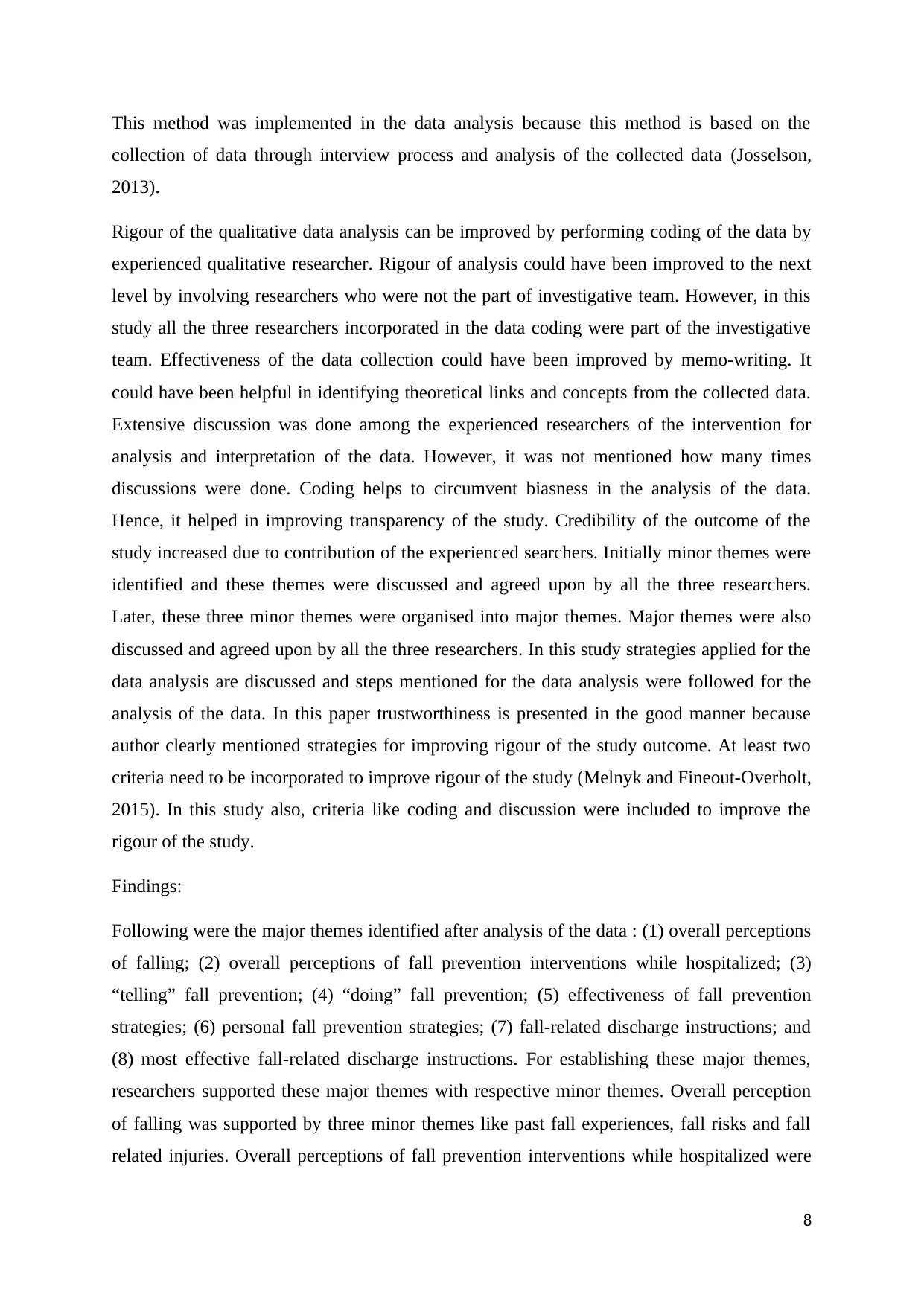
This method was implemented in the data analysis because this method is based on the
collection of data through interview process and analysis of the collected data (Josselson,
2013).
Rigour of the qualitative data analysis can be improved by performing coding of the data by
experienced qualitative researcher. Rigour of analysis could have been improved to the next
level by involving researchers who were not the part of investigative team. However, in this
study all the three researchers incorporated in the data coding were part of the investigative
team. Effectiveness of the data collection could have been improved by memo-writing. It
could have been helpful in identifying theoretical links and concepts from the collected data.
Extensive discussion was done among the experienced researchers of the intervention for
analysis and interpretation of the data. However, it was not mentioned how many times
discussions were done. Coding helps to circumvent biasness in the analysis of the data.
Hence, it helped in improving transparency of the study. Credibility of the outcome of the
study increased due to contribution of the experienced searchers. Initially minor themes were
identified and these themes were discussed and agreed upon by all the three researchers.
Later, these three minor themes were organised into major themes. Major themes were also
discussed and agreed upon by all the three researchers. In this study strategies applied for the
data analysis are discussed and steps mentioned for the data analysis were followed for the
analysis of the data. In this paper trustworthiness is presented in the good manner because
author clearly mentioned strategies for improving rigour of the study outcome. At least two
criteria need to be incorporated to improve rigour of the study (Melnyk and Fineout-Overholt,
2015). In this study also, criteria like coding and discussion were included to improve the
rigour of the study.
Findings:
Following were the major themes identified after analysis of the data : (1) overall perceptions
of falling; (2) overall perceptions of fall prevention interventions while hospitalized; (3)
“telling” fall prevention; (4) “doing” fall prevention; (5) effectiveness of fall prevention
strategies; (6) personal fall prevention strategies; (7) fall-related discharge instructions; and
(8) most effective fall-related discharge instructions. For establishing these major themes,
researchers supported these major themes with respective minor themes. Overall perception
of falling was supported by three minor themes like past fall experiences, fall risks and fall
related injuries. Overall perceptions of fall prevention interventions while hospitalized were
8
collection of data through interview process and analysis of the collected data (Josselson,
2013).
Rigour of the qualitative data analysis can be improved by performing coding of the data by
experienced qualitative researcher. Rigour of analysis could have been improved to the next
level by involving researchers who were not the part of investigative team. However, in this
study all the three researchers incorporated in the data coding were part of the investigative
team. Effectiveness of the data collection could have been improved by memo-writing. It
could have been helpful in identifying theoretical links and concepts from the collected data.
Extensive discussion was done among the experienced researchers of the intervention for
analysis and interpretation of the data. However, it was not mentioned how many times
discussions were done. Coding helps to circumvent biasness in the analysis of the data.
Hence, it helped in improving transparency of the study. Credibility of the outcome of the
study increased due to contribution of the experienced searchers. Initially minor themes were
identified and these themes were discussed and agreed upon by all the three researchers.
Later, these three minor themes were organised into major themes. Major themes were also
discussed and agreed upon by all the three researchers. In this study strategies applied for the
data analysis are discussed and steps mentioned for the data analysis were followed for the
analysis of the data. In this paper trustworthiness is presented in the good manner because
author clearly mentioned strategies for improving rigour of the study outcome. At least two
criteria need to be incorporated to improve rigour of the study (Melnyk and Fineout-Overholt,
2015). In this study also, criteria like coding and discussion were included to improve the
rigour of the study.
Findings:
Following were the major themes identified after analysis of the data : (1) overall perceptions
of falling; (2) overall perceptions of fall prevention interventions while hospitalized; (3)
“telling” fall prevention; (4) “doing” fall prevention; (5) effectiveness of fall prevention
strategies; (6) personal fall prevention strategies; (7) fall-related discharge instructions; and
(8) most effective fall-related discharge instructions. For establishing these major themes,
researchers supported these major themes with respective minor themes. Overall perception
of falling was supported by three minor themes like past fall experiences, fall risks and fall
related injuries. Overall perceptions of fall prevention interventions while hospitalized were
8
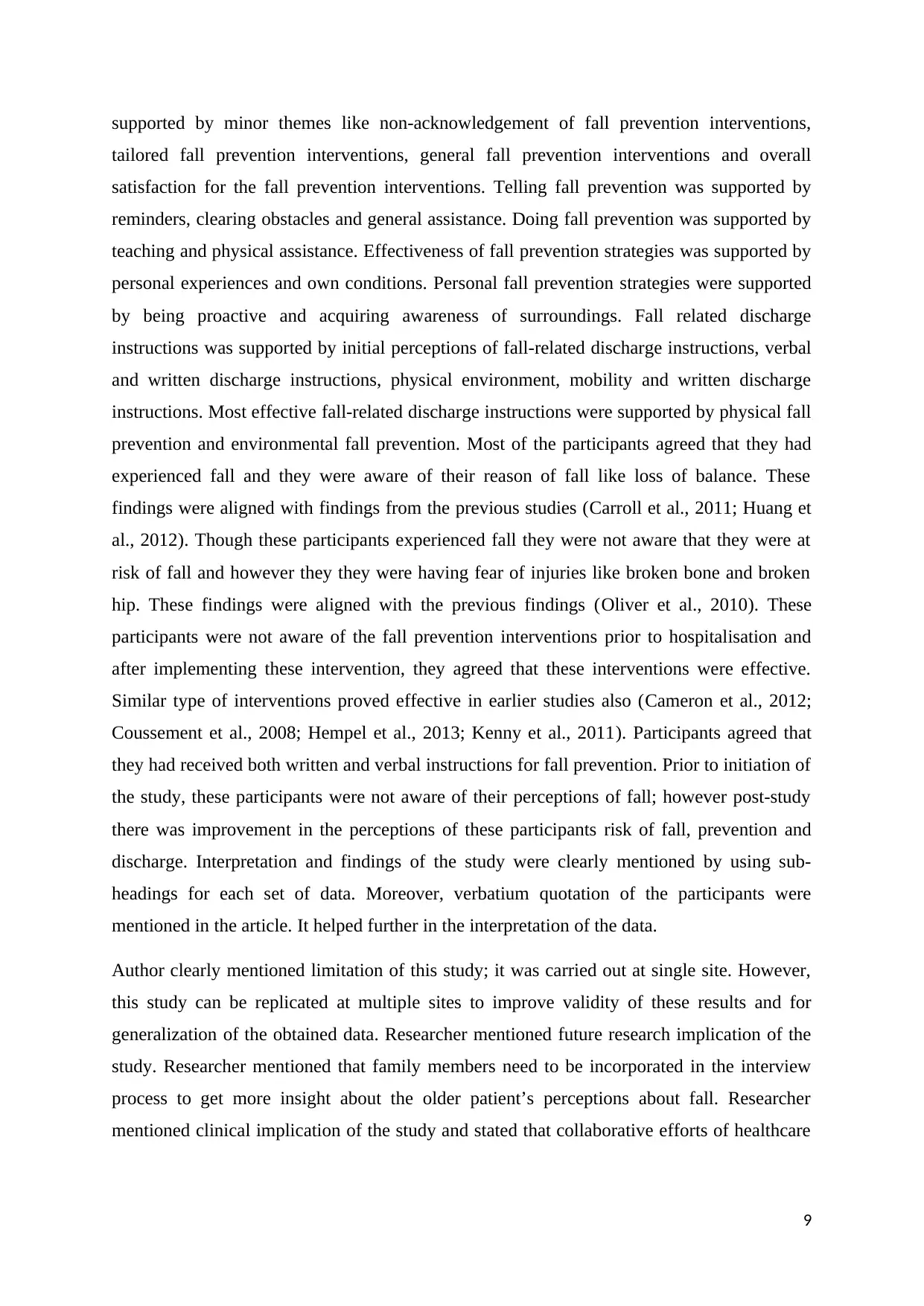
supported by minor themes like non-acknowledgement of fall prevention interventions,
tailored fall prevention interventions, general fall prevention interventions and overall
satisfaction for the fall prevention interventions. Telling fall prevention was supported by
reminders, clearing obstacles and general assistance. Doing fall prevention was supported by
teaching and physical assistance. Effectiveness of fall prevention strategies was supported by
personal experiences and own conditions. Personal fall prevention strategies were supported
by being proactive and acquiring awareness of surroundings. Fall related discharge
instructions was supported by initial perceptions of fall-related discharge instructions, verbal
and written discharge instructions, physical environment, mobility and written discharge
instructions. Most effective fall-related discharge instructions were supported by physical fall
prevention and environmental fall prevention. Most of the participants agreed that they had
experienced fall and they were aware of their reason of fall like loss of balance. These
findings were aligned with findings from the previous studies (Carroll et al., 2011; Huang et
al., 2012). Though these participants experienced fall they were not aware that they were at
risk of fall and however they they were having fear of injuries like broken bone and broken
hip. These findings were aligned with the previous findings (Oliver et al., 2010). These
participants were not aware of the fall prevention interventions prior to hospitalisation and
after implementing these intervention, they agreed that these interventions were effective.
Similar type of interventions proved effective in earlier studies also (Cameron et al., 2012;
Coussement et al., 2008; Hempel et al., 2013; Kenny et al., 2011). Participants agreed that
they had received both written and verbal instructions for fall prevention. Prior to initiation of
the study, these participants were not aware of their perceptions of fall; however post-study
there was improvement in the perceptions of these participants risk of fall, prevention and
discharge. Interpretation and findings of the study were clearly mentioned by using sub-
headings for each set of data. Moreover, verbatium quotation of the participants were
mentioned in the article. It helped further in the interpretation of the data.
Author clearly mentioned limitation of this study; it was carried out at single site. However,
this study can be replicated at multiple sites to improve validity of these results and for
generalization of the obtained data. Researcher mentioned future research implication of the
study. Researcher mentioned that family members need to be incorporated in the interview
process to get more insight about the older patient’s perceptions about fall. Researcher
mentioned clinical implication of the study and stated that collaborative efforts of healthcare
9
tailored fall prevention interventions, general fall prevention interventions and overall
satisfaction for the fall prevention interventions. Telling fall prevention was supported by
reminders, clearing obstacles and general assistance. Doing fall prevention was supported by
teaching and physical assistance. Effectiveness of fall prevention strategies was supported by
personal experiences and own conditions. Personal fall prevention strategies were supported
by being proactive and acquiring awareness of surroundings. Fall related discharge
instructions was supported by initial perceptions of fall-related discharge instructions, verbal
and written discharge instructions, physical environment, mobility and written discharge
instructions. Most effective fall-related discharge instructions were supported by physical fall
prevention and environmental fall prevention. Most of the participants agreed that they had
experienced fall and they were aware of their reason of fall like loss of balance. These
findings were aligned with findings from the previous studies (Carroll et al., 2011; Huang et
al., 2012). Though these participants experienced fall they were not aware that they were at
risk of fall and however they they were having fear of injuries like broken bone and broken
hip. These findings were aligned with the previous findings (Oliver et al., 2010). These
participants were not aware of the fall prevention interventions prior to hospitalisation and
after implementing these intervention, they agreed that these interventions were effective.
Similar type of interventions proved effective in earlier studies also (Cameron et al., 2012;
Coussement et al., 2008; Hempel et al., 2013; Kenny et al., 2011). Participants agreed that
they had received both written and verbal instructions for fall prevention. Prior to initiation of
the study, these participants were not aware of their perceptions of fall; however post-study
there was improvement in the perceptions of these participants risk of fall, prevention and
discharge. Interpretation and findings of the study were clearly mentioned by using sub-
headings for each set of data. Moreover, verbatium quotation of the participants were
mentioned in the article. It helped further in the interpretation of the data.
Author clearly mentioned limitation of this study; it was carried out at single site. However,
this study can be replicated at multiple sites to improve validity of these results and for
generalization of the obtained data. Researcher mentioned future research implication of the
study. Researcher mentioned that family members need to be incorporated in the interview
process to get more insight about the older patient’s perceptions about fall. Researcher
mentioned clinical implication of the study and stated that collaborative efforts of healthcare
9
⊘ This is a preview!⊘
Do you want full access?
Subscribe today to unlock all pages.

Trusted by 1+ million students worldwide
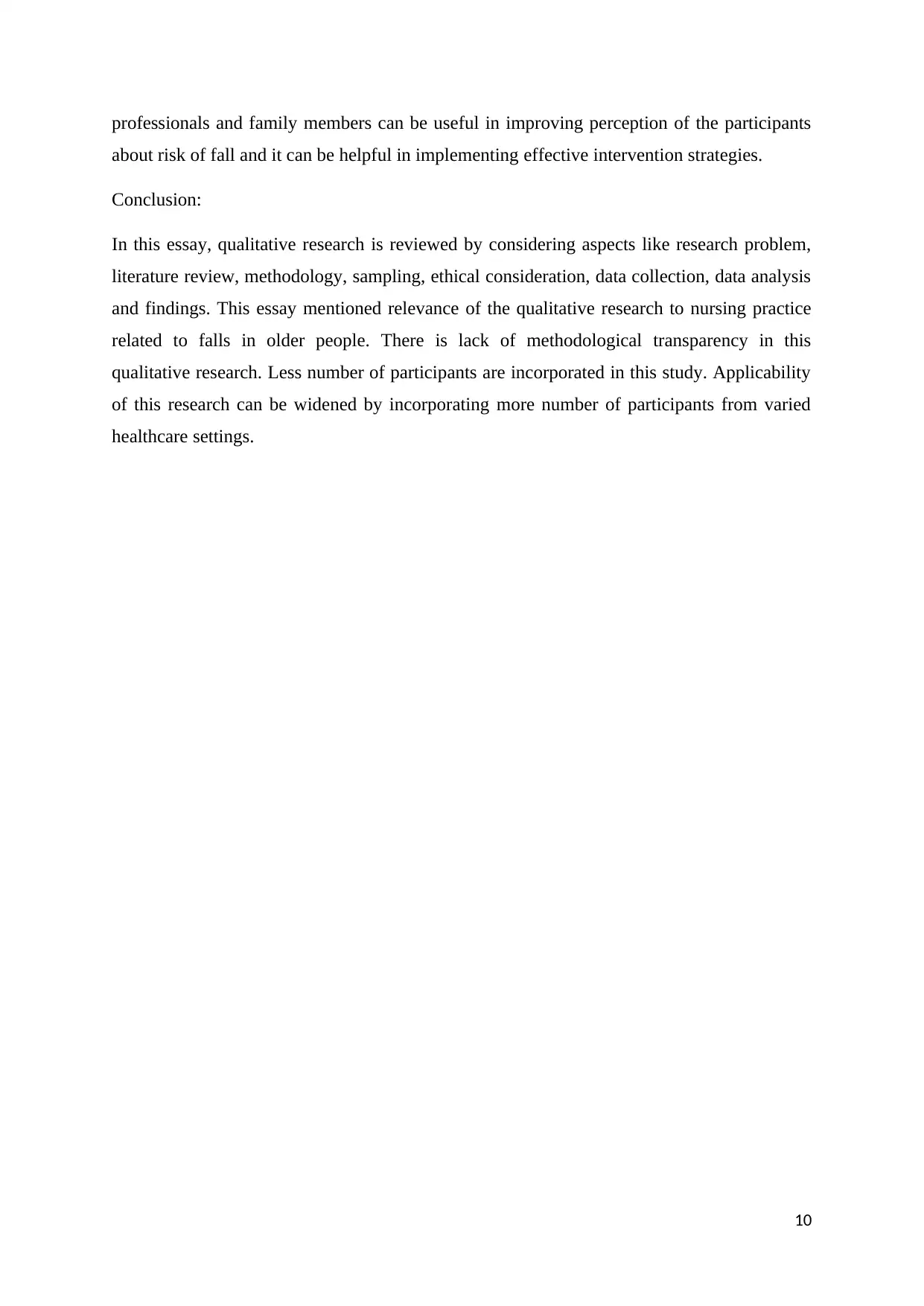
professionals and family members can be useful in improving perception of the participants
about risk of fall and it can be helpful in implementing effective intervention strategies.
Conclusion:
In this essay, qualitative research is reviewed by considering aspects like research problem,
literature review, methodology, sampling, ethical consideration, data collection, data analysis
and findings. This essay mentioned relevance of the qualitative research to nursing practice
related to falls in older people. There is lack of methodological transparency in this
qualitative research. Less number of participants are incorporated in this study. Applicability
of this research can be widened by incorporating more number of participants from varied
healthcare settings.
10
about risk of fall and it can be helpful in implementing effective intervention strategies.
Conclusion:
In this essay, qualitative research is reviewed by considering aspects like research problem,
literature review, methodology, sampling, ethical consideration, data collection, data analysis
and findings. This essay mentioned relevance of the qualitative research to nursing practice
related to falls in older people. There is lack of methodological transparency in this
qualitative research. Less number of participants are incorporated in this study. Applicability
of this research can be widened by incorporating more number of participants from varied
healthcare settings.
10
Paraphrase This Document
Need a fresh take? Get an instant paraphrase of this document with our AI Paraphraser
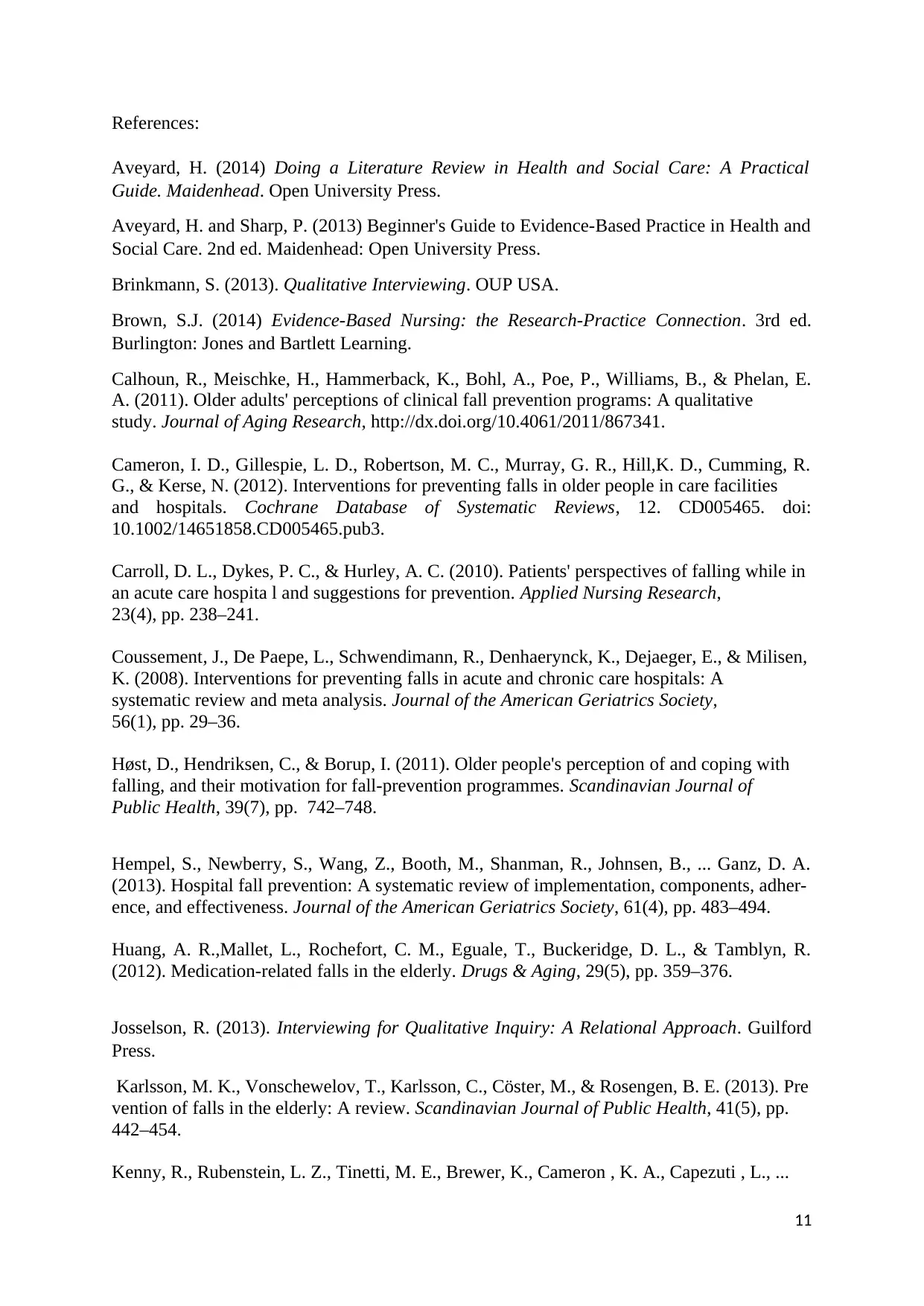
References:
Aveyard, H. (2014) Doing a Literature Review in Health and Social Care: A Practical
Guide. Maidenhead. Open University Press.
Aveyard, H. and Sharp, P. (2013) Beginner's Guide to Evidence-Based Practice in Health and
Social Care. 2nd ed. Maidenhead: Open University Press.
Brinkmann, S. (2013). Qualitative Interviewing. OUP USA.
Brown, S.J. (2014) Evidence-Based Nursing: the Research-Practice Connection. 3rd ed.
Burlington: Jones and Bartlett Learning.
Calhoun, R., Meischke, H., Hammerback, K., Bohl, A., Poe, P., Williams, B., & Phelan, E.
A. (2011). Older adults' perceptions of clinical fall prevention programs: A qualitative
study. Journal of Aging Research, http://dx.doi.org/10.4061/2011/867341.
Cameron, I. D., Gillespie, L. D., Robertson, M. C., Murray, G. R., Hill,K. D., Cumming, R.
G., & Kerse, N. (2012). Interventions for preventing falls in older people in care facilities
and hospitals. Cochrane Database of Systematic Reviews, 12. CD005465. doi:
10.1002/14651858.CD005465.pub3.
Carroll, D. L., Dykes, P. C., & Hurley, A. C. (2010). Patients' perspectives of falling while in
an acute care hospita l and suggestions for prevention. Applied Nursing Research,
23(4), pp. 238–241.
Coussement, J., De Paepe, L., Schwendimann, R., Denhaerynck, K., Dejaeger, E., & Milisen,
K. (2008). Interventions for preventing falls in acute and chronic care hospitals: A
systematic review and meta analysis. Journal of the American Geriatrics Society,
56(1), pp. 29–36.
Høst, D., Hendriksen, C., & Borup, I. (2011). Older people's perception of and coping with
falling, and their motivation for fall-prevention programmes. Scandinavian Journal of
Public Health, 39(7), pp. 742–748.
Hempel, S., Newberry, S., Wang, Z., Booth, M., Shanman, R., Johnsen, B., ... Ganz, D. A.
(2013). Hospital fall prevention: A systematic review of implementation, components, adher-
ence, and effectiveness. Journal of the American Geriatrics Society, 61(4), pp. 483–494.
Huang, A. R.,Mallet, L., Rochefort, C. M., Eguale, T., Buckeridge, D. L., & Tamblyn, R.
(2012). Medication-related falls in the elderly. Drugs & Aging, 29(5), pp. 359–376.
Josselson, R. (2013). Interviewing for Qualitative Inquiry: A Relational Approach. Guilford
Press.
Karlsson, M. K., Vonschewelov, T., Karlsson, C., Cöster, M., & Rosengen, B. E. (2013). Pre
vention of falls in the elderly: A review. Scandinavian Journal of Public Health, 41(5), pp.
442–454.
Kenny, R., Rubenstein, L. Z., Tinetti, M. E., Brewer, K., Cameron , K. A., Capezuti , L., ...
11
Aveyard, H. (2014) Doing a Literature Review in Health and Social Care: A Practical
Guide. Maidenhead. Open University Press.
Aveyard, H. and Sharp, P. (2013) Beginner's Guide to Evidence-Based Practice in Health and
Social Care. 2nd ed. Maidenhead: Open University Press.
Brinkmann, S. (2013). Qualitative Interviewing. OUP USA.
Brown, S.J. (2014) Evidence-Based Nursing: the Research-Practice Connection. 3rd ed.
Burlington: Jones and Bartlett Learning.
Calhoun, R., Meischke, H., Hammerback, K., Bohl, A., Poe, P., Williams, B., & Phelan, E.
A. (2011). Older adults' perceptions of clinical fall prevention programs: A qualitative
study. Journal of Aging Research, http://dx.doi.org/10.4061/2011/867341.
Cameron, I. D., Gillespie, L. D., Robertson, M. C., Murray, G. R., Hill,K. D., Cumming, R.
G., & Kerse, N. (2012). Interventions for preventing falls in older people in care facilities
and hospitals. Cochrane Database of Systematic Reviews, 12. CD005465. doi:
10.1002/14651858.CD005465.pub3.
Carroll, D. L., Dykes, P. C., & Hurley, A. C. (2010). Patients' perspectives of falling while in
an acute care hospita l and suggestions for prevention. Applied Nursing Research,
23(4), pp. 238–241.
Coussement, J., De Paepe, L., Schwendimann, R., Denhaerynck, K., Dejaeger, E., & Milisen,
K. (2008). Interventions for preventing falls in acute and chronic care hospitals: A
systematic review and meta analysis. Journal of the American Geriatrics Society,
56(1), pp. 29–36.
Høst, D., Hendriksen, C., & Borup, I. (2011). Older people's perception of and coping with
falling, and their motivation for fall-prevention programmes. Scandinavian Journal of
Public Health, 39(7), pp. 742–748.
Hempel, S., Newberry, S., Wang, Z., Booth, M., Shanman, R., Johnsen, B., ... Ganz, D. A.
(2013). Hospital fall prevention: A systematic review of implementation, components, adher-
ence, and effectiveness. Journal of the American Geriatrics Society, 61(4), pp. 483–494.
Huang, A. R.,Mallet, L., Rochefort, C. M., Eguale, T., Buckeridge, D. L., & Tamblyn, R.
(2012). Medication-related falls in the elderly. Drugs & Aging, 29(5), pp. 359–376.
Josselson, R. (2013). Interviewing for Qualitative Inquiry: A Relational Approach. Guilford
Press.
Karlsson, M. K., Vonschewelov, T., Karlsson, C., Cöster, M., & Rosengen, B. E. (2013). Pre
vention of falls in the elderly: A review. Scandinavian Journal of Public Health, 41(5), pp.
442–454.
Kenny, R., Rubenstein, L. Z., Tinetti, M. E., Brewer, K., Cameron , K. A., Capezuti , L., ...
11
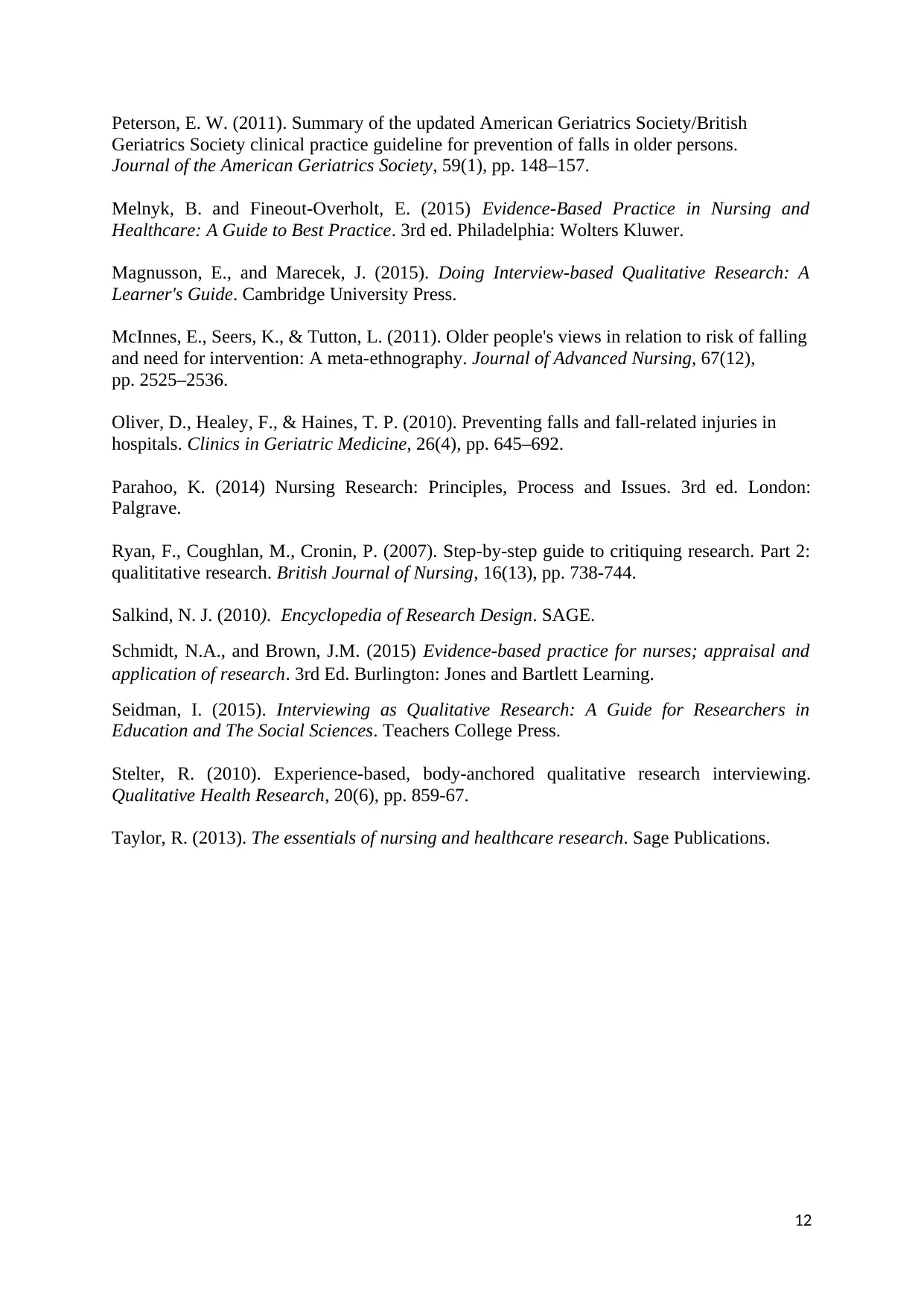
Peterson, E. W. (2011). Summary of the updated American Geriatrics Society/British
Geriatrics Society clinical practice guideline for prevention of falls in older persons.
Journal of the American Geriatrics Society, 59(1), pp. 148–157.
Melnyk, B. and Fineout-Overholt, E. (2015) Evidence-Based Practice in Nursing and
Healthcare: A Guide to Best Practice. 3rd ed. Philadelphia: Wolters Kluwer.
Magnusson, E., and Marecek, J. (2015). Doing Interview-based Qualitative Research: A
Learner's Guide. Cambridge University Press.
McInnes, E., Seers, K., & Tutton, L. (2011). Older people's views in relation to risk of falling
and need for intervention: A meta-ethnography. Journal of Advanced Nursing, 67(12),
pp. 2525–2536.
Oliver, D., Healey, F., & Haines, T. P. (2010). Preventing falls and fall-related injuries in
hospitals. Clinics in Geriatric Medicine, 26(4), pp. 645–692.
Parahoo, K. (2014) Nursing Research: Principles, Process and Issues. 3rd ed. London:
Palgrave.
Ryan, F., Coughlan, M., Cronin, P. (2007). Step-by-step guide to critiquing research. Part 2:
qualititative research. British Journal of Nursing, 16(13), pp. 738-744.
Salkind, N. J. (2010). Encyclopedia of Research Design. SAGE.
Schmidt, N.A., and Brown, J.M. (2015) Evidence-based practice for nurses; appraisal and
application of research. 3rd Ed. Burlington: Jones and Bartlett Learning.
Seidman, I. (2015). Interviewing as Qualitative Research: A Guide for Researchers in
Education and The Social Sciences. Teachers College Press.
Stelter, R. (2010). Experience-based, body-anchored qualitative research interviewing.
Qualitative Health Research, 20(6), pp. 859-67.
Taylor, R. (2013). The essentials of nursing and healthcare research. Sage Publications.
12
Geriatrics Society clinical practice guideline for prevention of falls in older persons.
Journal of the American Geriatrics Society, 59(1), pp. 148–157.
Melnyk, B. and Fineout-Overholt, E. (2015) Evidence-Based Practice in Nursing and
Healthcare: A Guide to Best Practice. 3rd ed. Philadelphia: Wolters Kluwer.
Magnusson, E., and Marecek, J. (2015). Doing Interview-based Qualitative Research: A
Learner's Guide. Cambridge University Press.
McInnes, E., Seers, K., & Tutton, L. (2011). Older people's views in relation to risk of falling
and need for intervention: A meta-ethnography. Journal of Advanced Nursing, 67(12),
pp. 2525–2536.
Oliver, D., Healey, F., & Haines, T. P. (2010). Preventing falls and fall-related injuries in
hospitals. Clinics in Geriatric Medicine, 26(4), pp. 645–692.
Parahoo, K. (2014) Nursing Research: Principles, Process and Issues. 3rd ed. London:
Palgrave.
Ryan, F., Coughlan, M., Cronin, P. (2007). Step-by-step guide to critiquing research. Part 2:
qualititative research. British Journal of Nursing, 16(13), pp. 738-744.
Salkind, N. J. (2010). Encyclopedia of Research Design. SAGE.
Schmidt, N.A., and Brown, J.M. (2015) Evidence-based practice for nurses; appraisal and
application of research. 3rd Ed. Burlington: Jones and Bartlett Learning.
Seidman, I. (2015). Interviewing as Qualitative Research: A Guide for Researchers in
Education and The Social Sciences. Teachers College Press.
Stelter, R. (2010). Experience-based, body-anchored qualitative research interviewing.
Qualitative Health Research, 20(6), pp. 859-67.
Taylor, R. (2013). The essentials of nursing and healthcare research. Sage Publications.
12
⊘ This is a preview!⊘
Do you want full access?
Subscribe today to unlock all pages.

Trusted by 1+ million students worldwide
1 out of 12
Related Documents
Your All-in-One AI-Powered Toolkit for Academic Success.
+13062052269
info@desklib.com
Available 24*7 on WhatsApp / Email
![[object Object]](/_next/static/media/star-bottom.7253800d.svg)
Unlock your academic potential
Copyright © 2020–2025 A2Z Services. All Rights Reserved. Developed and managed by ZUCOL.




